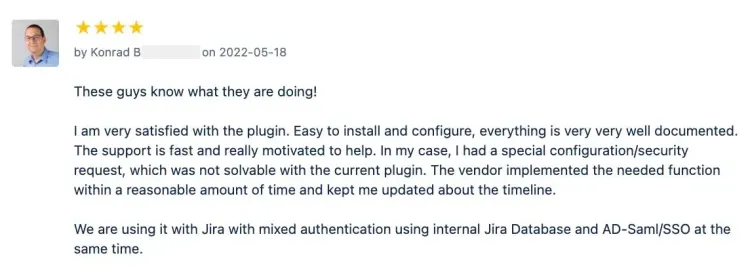The value of great first-line support in a B2B startup
Learn more about how Kantega SSO values customer driven development to ensure product quality and market success.

Sep 14, 2022
A successful company often starts with a good product but having a good product does not always end in a successful company. One of the reasons is that many start-ups focus mainly on the product and forget that the most important element in the value chain is the customer. In this article, I will describe how support inquiries drive forward product development in Kantega SSO, to the benefit of both the customer and the company.
Product focus vs. customer focus
It is easy to fall into the product trap. It is fun to work on an idea, and we want to believe that we, the product developers, know best which problems our product should solve. Thus, we tend to focus too much on the product and too little on the actual needs of the customer.

Without input from real customers, we base the product on our assumptions about the customer and the customer's needs. We claim that for a start-up there is just one valid assumption:
There is a high probability that our assumptions about the customer needs and how the product will solve their needs are wrong.
Customer-driven development
How can we ensure that the functionality we implement solves actual needs?

There are many ways to gather data about a customer's needs. Both before we start implementing the product and in the first phase of product development, we can make use of classic UX methods, such as interviews, surveys, prototyping and A/B testing. The common denominator is communication with the customer, as early as possible and as much as possible.
This often works well in the initial phase, at least when we have a clear picture of the customer. After launch, we will hopefully quickly see real customers buying the product. We have thus validated that our product solves a need, and that there are customers who are willing to pay for the product. This is also known as 'product-market fit'.

However, many start-up product companies fall into the product trap again at this point. We stop talking to the customer and focus too much on product development. Continuing with the classic methods for needs validation is a challenge for many start-ups. The costs are high, the income is small, and time is short. Business development and UX are prioritized in favor of design, implementation, and testing. Sometimes the design and testing are even cut altogether in this phase!
Some companies also find themselves in a position where it's difficult to maintain contact with real customers and users, as a result of the product being sold through external sales partners or other third-party suppliers. This is relatively common in the B2B market, and something we ourselves experienced early on.

The value of top-notch customer support
At Kantega SSO, the goal has always been to build new functionality that solves the pain of a customer quickly and efficiently, without compromising the underlying quality of the product. This is where our support philosophy comes into play. When the customer requests a support meeting, they will talk to the actual developers who implement the product from the very start.
In other words: They meet people who know the product at their fingertips and who have experience in solving similar problems.

In most cases, our developers can solve the customer's problem right away. It's often caused either by a misconfiguration or a conflict with another system. This is not necessarily a so-called user error but may be due to for instance a complicated infrastructure. Often, the system administrators who are setting up our solution have limited experience with different types of technical architectures. Our developers, on the other hand, have seen dozens of different layouts and know what works and what doesn’t.
Fixing the problem in the first support meeting is of course of great value for the customer, but such customer meetings are also of great value to us. For each support incident, we gather experience about various problems and needs, given the context of the customer. This is an ever-growing knowledge base that we consider when we do improvements or decide which functionality to develop next.

Sometimes, however, the customer has a need we cannot solve, simply because our products lack the required functionality. Many product companies will then put the customer's request for a functionality extension in a backlog. After a while, they may start to analyze the needs of the customer compared to the cost and value for the company. This is often a cumbersome process that steals time that could be spent on product improvements. In the meantime, the customer must live with a solution that doesn't solve their needs.
Such a process also requires that you can speak directly with other customers, who are experiencing the same problem, in the same context. It is difficult even if you have direct communication channels to your customers and close to impossible if you don't.

And this is perhaps where Kantega SSO reaps the greatest value from our customer support. Our developers are both those who accept requests for functionality extensions, and those who know the product best. We recognize the developers' expertise and have therefore given them the autonomy to judge, there and then, whether we should create an extension that solves the customer's specific needs.
Of course, this does not happen indiscriminately. When a developer is in a support meeting with a customer and receive a problem, they first make a quick estimate of the scope of the task. Then, they assess this against the customer's needs and the risk that the expansion will affect other parts of the system. Often the conclusion is that they can implement a quick-fix, which is sent to the specific customer for testing in their environment.

If the developer considers that the scope is too large to be implemented right away, or that the risk is high that other parts of the system will be negatively affected, they present the problem to the rest of the team the following day. The team then makes a quick analysis together and decides whether the task should be given priority or not. If the answer is yes, the team will pick up the task at the first opportunity.
We ensure quality by involving our dedicated QA people as soon as possible, regardless of whether the customer receives a snapshot for testing or if the team starts working on a major expansion. The extension only ends up in an actual release when the solution has been thoroughly tested and quality is assured.

Risk of spaghetticode and 'feature creep'
Most people with experience from IT development projects quickly see two possible problems with such a method:
Spaghetti code can quickly occur when different developers dabble on the codebase over an extended period. We solve this by using several methods: Firstly, new functionality must go through a code review. It ensures that other developers understand what has been done and why, and that the code is written in a way that harmonizes with the rest of the codebase. Another move we use is pair and mob programming. By having several people working on the same problem on the same screen, we benefit from the different experiences the developers have. For particularly intricate problems in this process, we also involve designers and testers. In addition, we regularly focus on code refactoring. Often, we decide to do a total rewrite of a complete class or a library. Refactoring and general code maintenance are included as regular activities in our annual process cycle.

The second problem that can occur is 'feature creep'. This is a problem that is more difficult to solve in our case. For security and privacy reasons we abstain from collecting any data on how customers use our systems. This means that we cannot analyze to what extent a functionality is used. We have found that the best way to cope with this risk, is to have designers doing periodically reviews of the various screens, preferably with at least one developer or a tester. This ensures that the behavior is consistent and makes sense across different screens. Sometimes a feature extension means that we must split a screenshot. This way we retain the richness of functionality without overwhelming our customers.
Good support enhances the customer experience
Kantega SSO has experienced growth every year since the launch of the first product in 2014, even though we've had limited focus on sales and marketing. We are convinced that offering premium support to all customers is a contributing factor to our success. Our vision is that UX and security go together, and good support enhances the customer experience in both areas. The support meeting thus becomes an important factor in building trust in us as a supplier, which in turn leads to loyal customers who are happy to recommend our products to other companies in their network.

All mentions in this article are taken from Kantega SSO's product pages on the Atlassian Marketplace.
